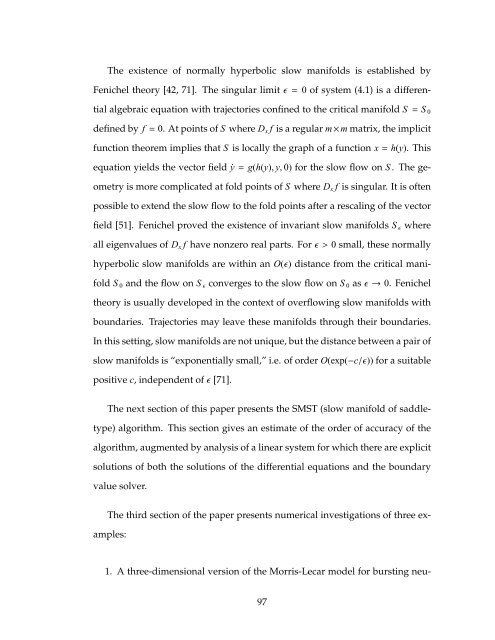multiple time scale dynamics with two fast variables and one slow ...
multiple time scale dynamics with two fast variables and one slow ...
multiple time scale dynamics with two fast variables and one slow ...
Create successful ePaper yourself
Turn your PDF publications into a flip-book with our unique Google optimized e-Paper software.
The existence of normally hyperbolic <strong>slow</strong> manifolds is established by<br />
Fenichel theory [42, 71]. The singular limitǫ= 0 of system (4.1) is a differen-<br />
tial algebraic equation <strong>with</strong> trajectories confined to the critical manifold S= S 0<br />
defined by f= 0. At points of S where Dx f is a regular m×m matrix, the implicit<br />
function theorem implies that S is locally the graph of a function x=h(y). This<br />
equation yields the vector field ˙y=g(h(y), y, 0) for the <strong>slow</strong> flow on S . The ge-<br />
ometry is more complicated at fold points of S where Dx f is singular. It is often<br />
possible to extend the <strong>slow</strong> flow to the fold points after a rescaling of the vector<br />
field [51]. Fenichel proved the existence of invariant <strong>slow</strong> manifolds Sǫ where<br />
all eigenvalues of Dx f have nonzero real parts. Forǫ> 0 small, these normally<br />
hyperbolic <strong>slow</strong> manifolds are <strong>with</strong>in an O(ǫ) distance from the critical mani-<br />
fold S 0 <strong>and</strong> the flow on Sǫ converges to the <strong>slow</strong> flow on S 0 asǫ→ 0. Fenichel<br />
theory is usually developed in the context of overflowing <strong>slow</strong> manifolds <strong>with</strong><br />
boundaries. Trajectories may leave these manifolds through their boundaries.<br />
In this setting, <strong>slow</strong> manifolds are not unique, but the distance between a pair of<br />
<strong>slow</strong> manifolds is “exp<strong>one</strong>ntially small,” i.e. of order O(exp(−c/ǫ)) for a suitable<br />
positive c, independent ofǫ [71].<br />
The next section of this paper presents the SMST (<strong>slow</strong> manifold of saddle-<br />
type) algorithm. This section gives an estimate of the order of accuracy of the<br />
algorithm, augmented by analysis of a linear system for which there are explicit<br />
solutions of both the solutions of the differential equations <strong>and</strong> the boundary<br />
value solver.<br />
The third section of the paper presents numerical investigations of three ex-<br />
amples:<br />
1. A three-dimensional version of the Morris-Lecar model for bursting neu-<br />
97
















